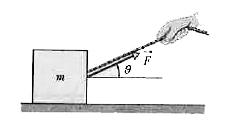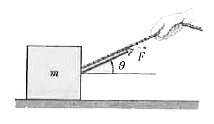SAMPLE PROBLEM from RESNICK AND HALLIDAY PHYSICS (HINGLISH) FORCE AND MOTION - I for Class 12
| Class 12 | PHYSICS |
| Chapter | FORCE AND MOTION - I |
| RESNICK AND HALLIDAY PHYSICS (HINGLISH) | SAMPLE PROBLEM |
| Medium | English |
| Academic Year | 2023-2024 |
Question 1
Here are examples of how to use Newton's second law for a quck when one or two forces act on it. Parts (a), (b), and ( c ) of Fig. 5-3 show three situations in which one or two forces act on a puck that moves over frictionless ice along an x axis, in one-dimensional motion. The puck's mass is m = 0.20 kg. Forces →F1 and →F2 are directed along the axis and have magnitudes F1=4.0 N and F2=2.0 N. Force →F3 is directed at angle θ=30∘ and has magnitude F3=1.0 N. In each situation, what is the acceleration of the puck ? View SolutionQuestion 2
Here we find a missing force by using the acceleration. In the overhead view of Fig. 5-4a, a 2.0 kg cookie tin is accelerated at 3.0 m/s2 in the direction shown by →a, over a frictionless horizontal surface. The acceleration is caused by three horizontal forces, only two of which are shown: →F1 of magnitude 10 N and →F2 of magnitude 20 N. What is the third force →F3 in unit-vector notation and in magnitude-angle notation? View SolutionQuestion 3
A mass 1 kg is attaced to the hook of a spring and the spring is suspended vertically from a ceiling (see Fig. 5.12a). The spring is displaced from its equilibrium position by a distance x. The spring constant of the spring is 2.0×102 N/m. Calculate the displacement x.

Figure 5-12 (a) Mass of 1 kg attached to a spring is suspended vertically. (b) Spring displace from equilibrium position by a distance x. View SolutionQuestion 4
A secret agent pushes two mysterious crates across a frozen river in the dark of night. The crates slide friction-lessly. Their masses are 150 kg (A) and 50 kg (B). The agent's hands exert a 100 N force on A (see Fig. 5-19). How much force does A exert on B? If there is no friction, can either block's acceleration be zero? Therefore, can ∑→Fon A=0? Therefore, can the force exerted on A by B (which is equal in magnitude to that exerted on B by A) "balance" (be equal and opposite to) the force exerted by the agent?
 View Solution
View SolutionQuestion 5
Figure 5-20 shows a block S (the sliding block) with mass M = 3.3 kg. The block is free to move along a horizontal frictionless surface and connected, by a cord that wraps over a frictionless pulley, to a second block H (the hanging block), with mass m = 2.1 kg. The cord and pulley have negligible masses compared to the blocks (they are "massless"). The hanging block H falls as the sliding block S accelerates to the right. Find (a) the acceleration of block S, (b) the acceleration of block H, and ( c ) the tension in the cord.
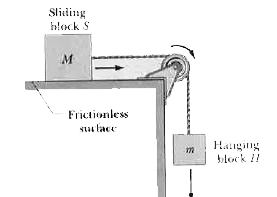
Figure 5.20 A block S of mass M is connected to a block H of mass m by a cord that wraps over a pulley. View SolutionQuestion 7
Here is an example of where you must dig information out of a graph, not just read off a number. In Fig. 5-24a, two forces are applied to a 4.00 kg block on a frictionless floor, but only force →F1 is indicated. That force has a fixed magnitude but can be applied at an adjustable angle θ to the positive direction of the x axis. Force F2 is horizontal and fixed in both magnitude and angle. Figure 5-24b gives the horizontal acceleration ax of the block for any given value of θ from 0∘ to 90∘. What is the value of ax for θ=180∘ ? View SolutionQuestion 8
In Fig. 5-25a, a passenger of mass m = 72.2 kg stands on a platform scale in an elevator cab. We are concerned with the scale readings when the cab is stationary and when it is moving up or down.
(a) Find a general solution for the scale readihng, whatever the vertical motion of the cab. View SolutionQuestion 10
In Fig. 5-26a, a constant horizontal force →Fapp of magnitude 20 N is applied to block A of mass mA=4.0 kg, which pushes against block B of mass mB=6.0 kg. The blocks slide over a frictionless surface, along an x axis.
(a) What is the acceleration of the blocks ?
Serious Error: Because force Fapp is applied directly to block A, we use Newton's second law to relate that force to the acceleration →a of block A. because the motion is along the x axis, we use that law for x components (Fnet, x=max), writing it as
Fapp=mAα.
However, this is seriously wrong because →Fapp is not the only horizontal force acting on block A. There is also the force →FAD from block B (Fig. 5-26b).
Dead-End Solution: Let us now include force →FAB by writing, again for the x axis,
Fapp−FAB=mAα.
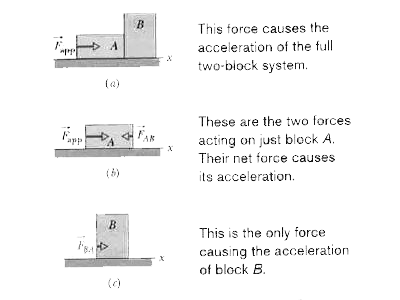
Figure 5-26 (a) A constant horizontal force →Fapp is applied to block A, which pushes against block B. (b) Two horizontal forces act on block A. (c) Only one horizontal force acts on block B.
(We use the minus sign to include the direction of →FAB.) Because FAB is a second unkon, we cannot solve this equation for a.
Successful Solution: Because of the direction in which force →Fapp is applied, the two blocks form a rigidly connected system. We can relate the net force on the system to the acceleration of the system with Newton's second law. Here, once again for the x axis, we can write that law as
Fapp=(mA+mB)α,
where now we properly apply →Fapp to the system with total mass mA+mB. Solving for a and substituting known values, we find
a=FappmA+mB=20 N)4.0 kg+6.0 kg)=2.0 m/s2.
Thus, the acceleration of the system and of each block is in the positive direction of the x axis and has the magnitude 2.0 m/s2.
(b) What is the (horizontal) force →FBA on block B from block A (Fig. 5-26c) ? View SolutionQuestion 11
In Fig. 5-27, a block attached to a chord is resting on an inclined plane. Let the mass of the block be 8.5 kg and the angle θ be 30∘.
(a) Find the tension in the cord and normal force acting on the block.
(b) If the cord is cut, find the magnitude of the resulting acceleration of the block.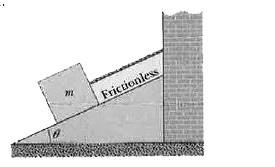
Figure 5-27 A block attached to a chord resting on an incline. View SolutionQuestion 14
In Fig. 5-31, three ballot boxes are connected by cords, one of which wraps over a pulley having negligible friction on its axle and negligible mass. The three masses are mA=30.0 kg, mB=40.0 kg, and mc=10.0 kg.
(a) When the assembly is released from rest, what is the tension in the cord connecting B and C?
(b) When the assembly is released from rest, how far does A move in the first 0.250 s (assuming it does not reach the pulley)?
 View Solution
View SolutionQuestion 15
A block of mass m1=3.70 kg on a frictionless plane inclined at angle 30.0∘ is connected by a cord over a massless, frictionless pulley to a second block of mass m2=2.30 kg (see Fig. 5-32).
(a) What is the magnitude of the acceleration of each block?
(b) What is the direction of the acceleration of the hanging block ?
(c) What is the tension in the cord?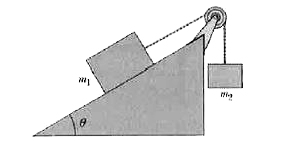
View SolutionQuestion 16
Figure 5-34 shows three blocks attached by cords that loop over frictionless pulleys. Block B lies on a friction-less table, the masses are mA=6.00 kg, mB=8.00 kg, and mC=10.0 kg. When the blocks are released, what is the tension in the cord at the right?

Figure 5-34 Three blocks attached over two pulleys by a cord. View SolutionQuestion 17
A block of mass M is pulled along a horizontal frictionless surface by a rope of mass m, as shown in Fig. 5-35. A horizontal force acts on one end of the rope.

(a) Show that the rope must sag, even if only by an imperceptible amount.
(b) Then, assuming that the sag is negligible, find the acceleration of rope and block.
(c) Find the force on the block from the rope.
(d) Find the tension in the rope at its midpoint.
View SolutionQuestion 18
A customer sits in an amusement park ride in which the compartment is to be pulled downward in the negative direction of a y axis with an acceleration magnitude of 1.24 g, with g=9.80 m/s2. A 0.567 g coin rests on the customer's knee. Once the motion begins and in unit-vector notation,
(a) What is the coin's acceleration relative to the ground? View Solution

